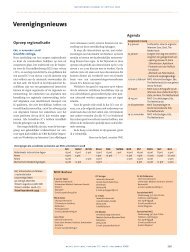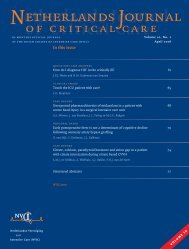Netherlands Journal
NJCC Volume 10, Oktober 2006
NJCC Volume 10, Oktober 2006
- No tags were found...
You also want an ePaper? Increase the reach of your titles
YUMPU automatically turns print PDFs into web optimized ePapers that Google loves.
netherlands journal of critical care<br />
Copyright ©2006, Nederlandse Vereniging voor Intensive Care. All Rights Reserved. Received March 2006; accepted in revised form August 2006<br />
r e v i e w<br />
Intensive Care and Recombinant<br />
Factor VIIa Use: A Review<br />
R. Sherrington 1 , A. Tillyard 1 , A. Rhodes 2 and R.M. Grounds 2<br />
1 Specialist Registrar in Intensive Care, St Georges Hospital, London, UK.<br />
2 Consultant in Intensive Care, St Georges Hospital, London, UK.<br />
Abstract. Objective – Currently recombinant factor VIIa (rFVIIa) is licensed only for use in the management of haemorrhage in<br />
patients with congenital and acquired haemophilia, congenital factor VII deficiency and Glanzmann’s thrombasthenia that is<br />
refractory to platelet transfusion. However, there has recently been a profusion of case reports and a number of randomised controlled<br />
trials regarding the use of rFVIIa in the setting of life-threatening bleeding in patients without specific coagulopathies. The<br />
purpose of this review is to examine its mechanism of action, use and efficacy in these ‘non-licensed’ conditions that often require<br />
intensive care support.<br />
Search Strategy – A Pubmed and Medline search in November 2005 was used with the keywords ‘recombinant activated factor VIIa’<br />
and ‘critical care’. Any appropriate referenced articles from this search were also retrieved.<br />
Summary of findings – In the majority of clinical settings there is a lack of prospective randomised controlled trials of rFVIIa. The few<br />
that have been performed have shown minimal mortality and morbidity benefit.<br />
Conclusion – Further, well-performed, randomised controlled trials are recommended. Until this time, rFVIIa should be reserved for<br />
clinical trials and patients with life-threatening surgical bleeding where all conventional treatments have at least been initiated, and<br />
shown to have failed.<br />
Introduction<br />
Factor VIIa is not a new agent. Following reports of the use of prothrombin<br />
complex concentrate on patients with haemophilia and antibodies<br />
to Factor VIII, Hedner and Kisiel first reported, in 1983, the<br />
successful use of plasma-derived activated Factor VIIa (FVIIa) in controlling<br />
haemorrhage in two patients with Factor VIII antibodies [1].<br />
The development of recombinant human Factor VIIa - rFVIIa<br />
– (‘eptacog alpha’ - NovoSeven by Novo Nordisk A/S, Bagsvaerd,<br />
Denmark) using transfected baby hamster cells led to the widespread<br />
licence in many countries for the treatment of spontaneous and surgical<br />
bleeding in patients with inhibitors against FVIII or Factor IX.<br />
There have now been over 700,000 doses administered to patients<br />
with haemophilia [2].<br />
In 1999 Kenet et al reported the first use of rFVIIa in a patient<br />
without a specific factor deficiency who had a high velocity gunshot<br />
wound to the inferior vena cava [3]. In 2002, O’Neill et al [4] achieved<br />
haemorrhagic control with a single dose of rFVIIa in a victim of multiple<br />
stab wounds who had inadequate haemostasis despite 100 units<br />
of blood products.<br />
Currently rFVIIa is licensed for use in the management of haemorrhage<br />
in patients with congenital and acquired haemophilia, congenital<br />
factor VII deficiency and Glanzmann’s thrombasthenia that<br />
is refractory to platelet transfusion. However, since the publication<br />
by Kenet et al, interest in the application of this treatment to other<br />
medical and surgical conditions has rapidly increased.<br />
The purpose of this paper is to review rFVIIa’s efficacy from the<br />
published results in conditions that are seen in the intensive care unit<br />
(ITU). To achieve this, we conducted a Pubmed and Medline search<br />
Correspondence:<br />
Andrew Tillyard<br />
E-mail: arjtillyard@hotmail.com<br />
in November 2005 using the keywords ‘recombinant activated factor<br />
VIIa’ and ‘critical care’, and retrieved any appropriate referenced<br />
articles.<br />
Coagulation and Factor VIIa<br />
Pharmacological doses of rFVIIa increase thrombin generation locally<br />
without systemic activation. In order to understand the mechanism<br />
by which this occurs we must first understand the process of<br />
coagulation in vivo.<br />
The traditional model of coagulation includes the intrinsic and<br />
extrinsic or tissue factor (TF) pathways. However, it is now believed<br />
that the TF pathway has the greatest importance to normal haemostasis<br />
[5]. In 2001, Hoffmann and colleagues [6] proposed a cellbased<br />
model of coagulation, which emphasises the cellular control<br />
of coagulation in vivo, based on the expression of tissue factor. They<br />
describe three overlapping phases, which occur on different cell surfaces.<br />
The phases are called initiation, amplification and propagation.<br />
Initiation<br />
TF is present in the sub-endothelium and other tissues that are not<br />
normally exposed to blood [7,8]. Damage to the vascular endothelium<br />
exposes this TF and is the primary physiological initiator of coagulation<br />
[5]. Both Factor VII and activated Factor VII (1% of the total<br />
circulating FVII) bind to TF. This FVIIa/TF complex inturn activates<br />
both factors X and IX [9]. This generation of a small amount of factor<br />
Xa initiates a cascade process leading to the further generation of factor<br />
Xa and thrombin [9,10]. The initiation of coagulation also leads<br />
to the inhibition of fibrinolytic activity.<br />
Amplification<br />
This starts with vascular disruption and exposure of tissue factor<br />
bearing cells to platelets, Von Willebrand factor and Factor VIII. The<br />
542 neth j crit care • volume 10 • no 5 • october 2006







